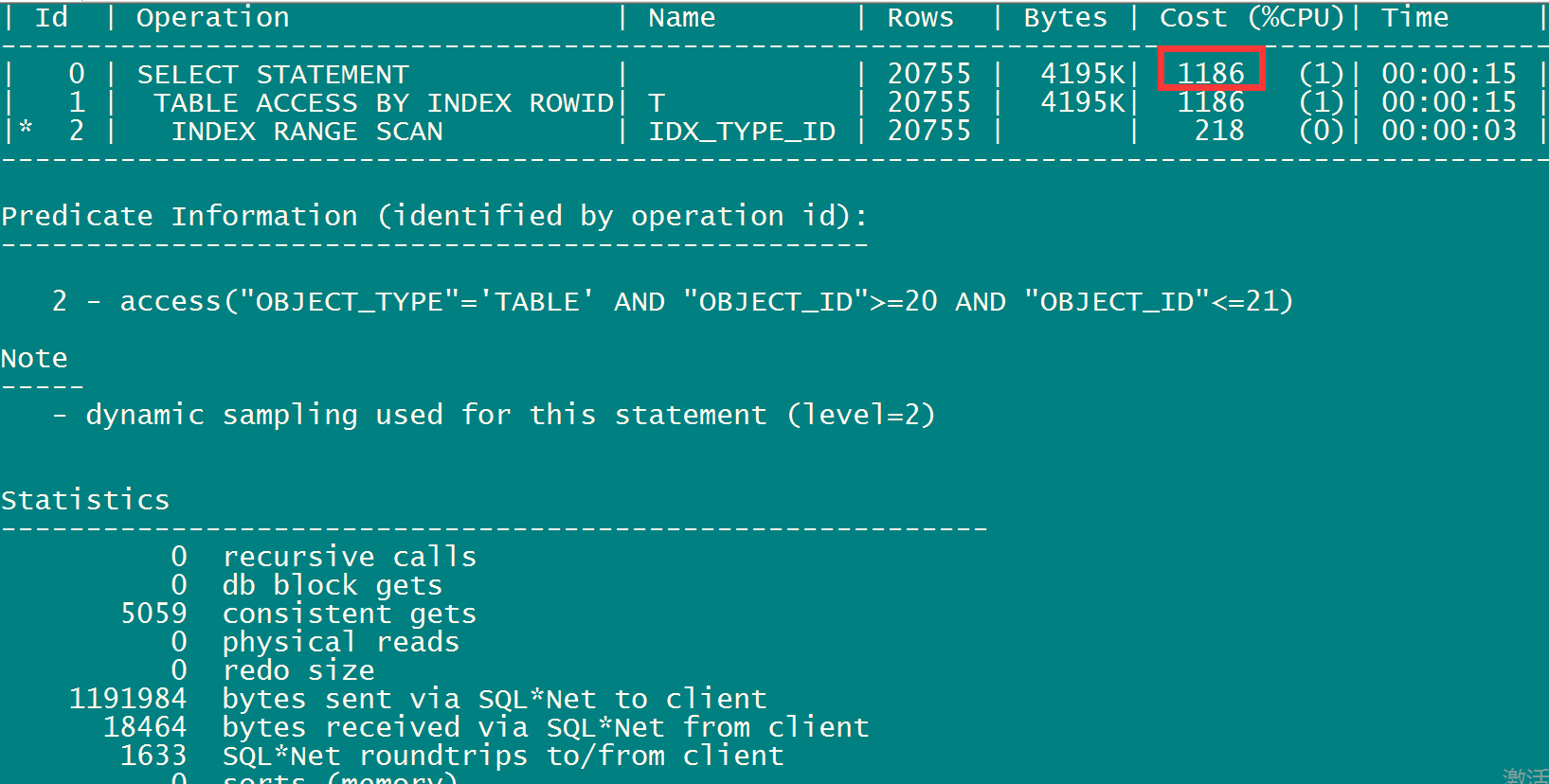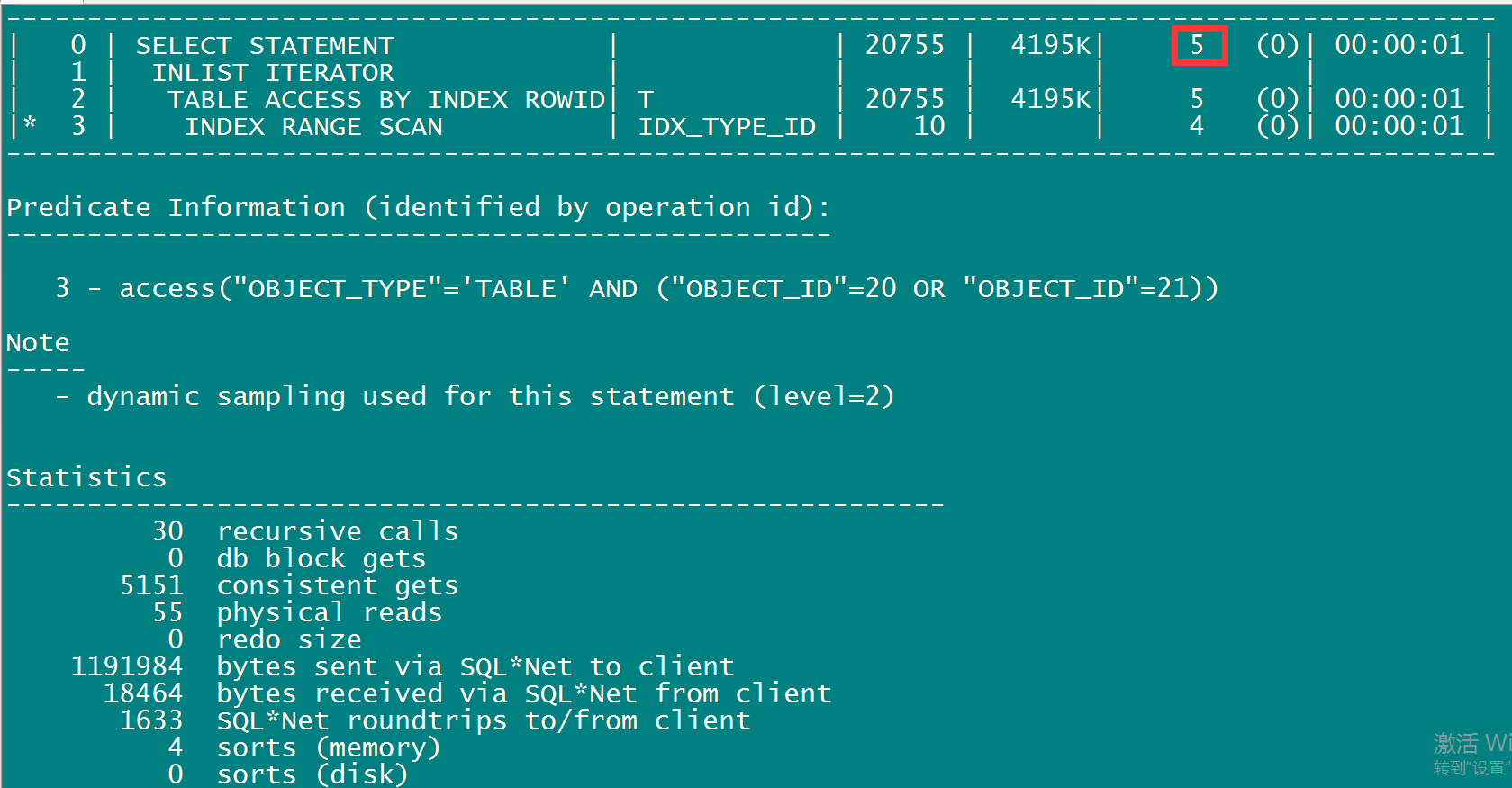oracle 优化之组合索引
组合索引适用场景:
1.适用在单独查询返回记录很多,组合查询后忽然返回记录很少的情况:
比如where 学历=硕士以上 返回不少的记录
比如where 职业=收银员 同样返回不少的记录
于是无论哪个条件查询做索引,都不合适。
可是,如果学历为硕士以上,同时职业又是收银员的,返回的就少之又少了。
于是联合索引就可以这么开始建了。
2.组合查询的组合顺序,要考虑单独的前缀查询情况(否则单独前缀查询的索引不能生效或者只能用到跳跃索引)
比如你在建id,object_type的联合索引时,要看考虑是单独where id=xxx查询的多,还是单独where object_type查询的多。
这里细节就暂时略去了,在案例的部分中还有描述
3.仅等值无范围查询时,组合索引顺序不影响性能(比如where col1=xxx and col2=xxx,无论COL1+COL2组合还是COL2+COL1组合)
drop table t purge;
create table t as select * from dba_objects;
insert into t select * from t;
insert into t select * from t;
insert into t select * from t;
update t set object_id=rownum ;
commit;
create index idx_id_type on t(object_id,object_type);
create index idx_type_id on t(object_type,object_id);
set autotrace off
alter session set statistics_level=all ;
set linesize 366
create index idx_id_type on t(object_id,object_type);
create index idx_type_id on t(object_type,object_id);
set autotrace off
alter session set statistics_level=all ;
set linesize 200
select /*+index(t,idx_id_type)*/ * from t where object_id=20 and object_type='TABLE';
select * from table(dbms_xplan.display_cursor(null,null,'allstats last'));
PLAN_TABLE_OUTPUT
--------------------------------------------------------------------------------------------------------------------------------------------------------------------------------------------------------
SQL_ID 7qydm6x641kx4, child number 1
-------------------------------------
select /*+index(t,idx_id_type)*/ * from t where object_id=20 and
object_type='TABLE'
Plan hash value: 1470938839
-----------------------------------------------------------------------------------------------------
| Id | Operation | Name | Starts | E-Rows | A-Rows | A-Time | Buffers |
-----------------------------------------------------------------------------------------------------
| 0 | SELECT STATEMENT | | 1 | | 1 |00:00:00.01 | 5 |
PLAN_TABLE_OUTPUT
--------------------------------------------------------------------------------------------------------------------------------------------------------------------------------------------------------
| 1 | TABLE ACCESS BY INDEX ROWID| T | 1 | 1 | 1 |00:00:00.01 | 5 |
|* 2 | INDEX RANGE SCAN | IDX_ID_TYPE | 1 | 1 | 1 |00:00:00.01 | 4 |
-----------------------------------------------------------------------------------------------------
Predicate Information (identified by operation id):
---------------------------------------------------
2 - access("OBJECT_ID"=20 AND "OBJECT_TYPE"='TABLE')
Note
-----
PLAN_TABLE_OUTPUT
--------------------------------------------------------------------------------------------------------------------------------------------------------------------------------------------------------
- cardinality feedback used for this statement
24 rows selected.
可以看出走的是索引范围扫描,并且回表。
--4.组合索引最佳顺序一般是将列等值查询的列置前。
(测试组合索引在条件是不等的情况下的情况,条件经常是不等的,要放在后面,让等值的在前面)
Execution Plan
----------------------------------------------------------
Plan hash value: 1470938839
-------------------------------------------------------------------------------------------
| Id | Operation | Name | Rows | Bytes | Cost (%CPU)| Time |
-------------------------------------------------------------------------------------------
| 0 | SELECT STATEMENT | | 16 | 3312 | 52 (0)| 00:00:01 |
| 1 | TABLE ACCESS BY INDEX ROWID| T | 16 | 3312 | 52 (0)| 00:00:01 |
|* 2 | INDEX RANGE SCAN | IDX_ID_TYPE | 50 | | 51 (0)| 00:00:01 |
-------------------------------------------------------------------------------------------
Predicate Information (identified by operation id):
---------------------------------------------------
2 - access("OBJECT_ID">=20 AND "OBJECT_TYPE"='TABLE' AND "OBJECT_ID"<2000)
filter("OBJECT_TYPE"='TABLE')
Note
-----
- dynamic sampling used for this statement (level=2)
Statistics
----------------------------------------------------------
1 recursive calls
0 db block gets
89 consistent gets
0 physical reads
0 redo size
51596 bytes sent via SQL*Net to client
875 bytes received via SQL*Net from client
34 SQL*Net roundtrips to/from client
0 sorts (memory)
0 sorts (disk)
493 rows processed
通过索引快速扫面获得行ID进行回表。
5.注意组合索引与组合条件中关于IN 的优化
案例1
UPDATE t SET OBJECT_ID=20 WHERE ROWNUM<=26000;
UPDATE t SET OBJECT_ID=21 WHERE OBJECT_ID<>20;
COMMIT;
set linesize 1000
set pagesize 1
alter session set statistics_level=all ;
select /*+index(t,idx1_object_id)*/ * from t where object_TYPE='TABLE' AND OBJECT_ID >= 20 AND OBJECT_ID<= 21;
Execution Plan
----------------------------------------------------------
Plan hash value: 3420768628
-------------------------------------------------------------------------------------------
| Id | Operation | Name | Rows | Bytes | Cost (%CPU)| Time |
-------------------------------------------------------------------------------------------
| 0 | SELECT STATEMENT | | 20755 | 4195K| 1186 (1)| 00:00:15 |
| 1 | TABLE ACCESS BY INDEX ROWID| T | 20755 | 4195K| 1186 (1)| 00:00:15 |
|* 2 | INDEX RANGE SCAN | IDX_TYPE_ID | 20755 | | 218 (0)| 00:00:03 |
-------------------------------------------------------------------------------------------
Predicate Information (identified by operation id):
---------------------------------------------------
2 - access("OBJECT_TYPE"='TABLE' AND "OBJECT_ID">=20 AND "OBJECT_ID"<=21)
Note
-----
- dynamic sampling used for this statement (level=2)
Statistics
----------------------------------------------------------
0 recursive calls
0 db block gets
5059 consistent gets
0 physical reads
0 redo size
1191984 bytes sent via SQL*Net to client
18464 bytes received via SQL*Net from client
1633 SQL*Net roundtrips to/from client
0 sorts (memory)
0 sorts (disk)
24472 rows processed

select /*+index(t,idx1_object_id)*/ * from t where object_TYPE='TABLE' AND OBJECT_ID in (20,21);

以上两个语句:
select /*+index(t,idx1_object_id)*/ * from t where object_TYPE='TABLE' AND OBJECT_ID >= 20 AND OBJECT_ID<= 21; --CPU cost消耗1186
select /*+index(t,idx1_object_id)*/ * from t where object_TYPE='TABLE' AND OBJECT_ID in (20,21); -- CPU cost消耗仅仅为5
为何消耗的CPU成本差距这么大?
在人为的思考中,我们人为认为 (OBJECT_ID >= 20 AND OBJECT_ID<= 21) = in (20,21),而其实oracle 不这么认为in (20,21) 只有两个值,而(OBJECT_ID >= 20 AND OBJECT_ID<= 21)走索引中间有无穷个键值。所以第二句消耗的CPU COST仅仅为5。
6.依然是关于IN的优化 (col1,col2,col3的索引情况,如果没有为COL2赋予查询条件时,COL3只能起到检验作用)
drop table t purge;
create table t as select * from dba_objects;
UPDATE t SET OBJECT_ID=20 WHERE ROWNUM<=26000;
UPDATE t SET OBJECT_ID=21 WHERE OBJECT_ID<>20;
Update t set object_id=22 where rownum<=10000;
COMMIT;
create index idx_union on t(object_type,object_id,owner);
set autotrace traceonly
select * from t where object_type='VIEW' and OWNER='SYS';
select * from table(dbms_xplan.display_cursor(null,null,'allstats last'));
Execution Plan
----------------------------------------------------------
Plan hash value: 1570829420
-----------------------------------------------------------------------------------------
| Id | Operation | Name | Rows | Bytes | Cost (%CPU)| Time |
-----------------------------------------------------------------------------------------
| 0 | SELECT STATEMENT | | 3369 | 681K| 20 (0)| 00:00:01 |
| 1 | TABLE ACCESS BY INDEX ROWID| T | 3369 | 681K| 20 (0)| 00:00:01 |
|* 2 | INDEX RANGE SCAN | IDX_UNION | 14 | | 19 (0)| 00:00:01 |
-----------------------------------------------------------------------------------------
Predicate Information (identified by operation id):
---------------------------------------------------
2 - access("OBJECT_TYPE"='VIEW' AND "OWNER"='SYS')
filter("OWNER"='SYS')
Note
-----
- dynamic sampling used for this statement (level=2)
Statistics
----------------------------------------------------------
0 recursive calls
0 db block gets
686 consistent gets
0 physical reads
0 redo size
157650 bytes sent via SQL*Net to client
3405 bytes received via SQL*Net from client
264 SQL*Net roundtrips to/from client
0 sorts (memory)
0 sorts (disk)
3938 rows processed
SQL>
23 rows selected.
Execution Plan
----------------------------------------------------------
Plan hash value: 3713220770
----------------------------------------------------------------------------------------------------
| Id | Operation | Name | Rows | Bytes | Cost (%CPU)| Time |
----------------------------------------------------------------------------------------------------
| 0 | SELECT STATEMENT | | 8168 | 16336 | 29 (0)| 00:00:01 |
| 1 | COLLECTION ITERATOR PICKLER FETCH| DISPLAY_CURSOR | 8168 | 16336 | 29 (0)| 00:00:01 |
----------------------------------------------------------------------------------------------------
Statistics
----------------------------------------------------------
27 recursive calls
0 db block gets
136 consistent gets
0 physical reads
0 redo size
1925 bytes sent via SQL*Net to client
534 bytes received via SQL*Net from client
3 SQL*Net roundtrips to/from client
2 sorts (memory)
0 sorts (disk)
23 rows processed
select /*+INDEX(T,idx_union)*/ * from t T where object_type='VIEW' and OBJECT_ID IN (20,21,22) AND OWNER='SYS';
select * from table(dbms_xplan.display_cursor(null,null,'allstats last'));
Execution Plan
----------------------------------------------------------
Plan hash value: 306189815
------------------------------------------------------------------------------------------
| Id | Operation | Name | Rows | Bytes | Cost (%CPU)| Time |
------------------------------------------------------------------------------------------
| 0 | SELECT STATEMENT | | 3369 | 681K| 6 (0)| 00:00:01 |
| 1 | INLIST ITERATOR | | | | | |
| 2 | TABLE ACCESS BY INDEX ROWID| T | 3369 | 681K| 6 (0)| 00:00:01 |
|* 3 | INDEX RANGE SCAN | IDX_UNION | 1 | | 5 (0)| 00:00:01 |
------------------------------------------------------------------------------------------
Predicate Information (identified by operation id):
---------------------------------------------------
3 - access("OBJECT_TYPE"='VIEW' AND ("OBJECT_ID"=20 OR "OBJECT_ID"=21 OR
"OBJECT_ID"=22) AND "OWNER"='SYS')
Note
-----
- dynamic sampling used for this statement (level=2)
Statistics
----------------------------------------------------------
0 recursive calls
0 db block gets
687 consistent gets
0 physical reads
0 redo size
157650 bytes sent via SQL*Net to client
3405 bytes received via SQL*Net from client
264 SQL*Net roundtrips to/from client
0 sorts (memory)
0 sorts (disk)
3938 rows processed
SQL>
23 rows selected.
Execution Plan
----------------------------------------------------------
Plan hash value: 3713220770
----------------------------------------------------------------------------------------------------
| Id | Operation | Name | Rows | Bytes | Cost (%CPU)| Time |
----------------------------------------------------------------------------------------------------
| 0 | SELECT STATEMENT | | 8168 | 16336 | 29 (0)| 00:00:01 |
| 1 | COLLECTION ITERATOR PICKLER FETCH| DISPLAY_CURSOR | 8168 | 16336 | 29 (0)| 00:00:01 |
----------------------------------------------------------------------------------------------------
Statistics
----------------------------------------------------------
15 recursive calls
0 db block gets
0 consistent gets
0 physical reads
0 redo size
1862 bytes sent via SQL*Net to client
534 bytes received via SQL*Net from client
3 SQL*Net roundtrips to/from client
2 sorts (memory)
0 sorts (disk)
23 rows processed
可以看出,select * from t where object_type='VIEW' and OWNER='SYS'; 这一条语句跟select /*+INDEX(T,idx_union)*/ * from t T where object_type='VIEW' and OBJECT_ID IN (20,21,22) AND OWNER='SYS';这一条语句代价等价,因为此案例中object_type='VIEW' 且OBJECT_ID 只有20,21,22 这三条记录,所以如果没有为COL2赋予查询条件时,COL3只能起到检验作用。
oracle 优化之组合索引的更多相关文章
- oracle 优化——索引与组合索引
1.索引结构.第一张图是索引的官方图解,右侧是存储方式的图解. 图中很清晰的展示了索引存储的状况. 在leaf 节点中存储了一列,索引所对应项的 :值,rowId,长度,头信息(控制信息) 这样我们就 ...
- Oracle中组合索引的使用详解(转)
在Oracle中可以创建组合索引,即同时包含两个或两个以上列的索引.在组合索引的使用方面,Oracle有以下特点: 1. 当使用基于规则的优化器(RBO)时,只有当组合索引的前导列出现在SQL语句的w ...
- Oracle组合索引与回表
回表 简单来说就是数据库根据索引找到了指定的记录所在行后,还需要根据rowid再次到数据块里取数据的操作. "回表"一般就是指执行计划里显示的"TABLE ACCESS ...
- [慢查优化]建索引时注意字段选择性 & 范围查询注意组合索引的字段顺序
文章转自:http://www.cnblogs.com/zhengyun_ustc/p/slowquery2.html 写在前面的话: 之前曾说过"不要求每个人一定理解 联表查询(join/ ...
- Oracle 优化——位图、函数等索引介绍
一.位图索引 我将使用一个例子,来描述位图索引的存储,并分析它的优点. Table :Loans 放贷信息 ID userId 行业投向 币种 证件类型 还本付息方式 状态 1 1 农业 人民币 身份 ...
- MongoDB 创建基础索引、组合索引、唯一索引以及优化
一.索引 MongoDB 提供了多样性的索引支持,索引信息被保存在system.indexes 中,且默认总是为_id创建索引,它的索引使用基本和MySQL 等关系型数据库一样.其实可以这样说说,索引 ...
- SQL Server性能优化(12)非聚集索引的组合索引存储结构
一,非聚集索引组合索引 用户可以在多个列上建立索引,这种索引叫做复合索引(组合索引).但复合索引在数据库操作期间所需的开销更小,可以代替多个单一索引.当表的行数远远大于索引键的数目时,使用这种方式可以 ...
- 一个Web报表项目的性能分析和优化实践(四):MySQL建立索引,唯一索引和组合索引
先大致介绍下项目的数据库信息. 数据库A:主要存放的通用的表,如User.Project.Report等. 数据库B.C.D:一个项目对应一个数据库,而且这几个项目的表是完全一样的. 数据库表的特点 ...
- oracle 索引,组合索引
1. 组合索引 id,code 组合 id,number 组合 2. 排序cost 使用 id ,cost=0 使用 id+code cost=0 使用 id+number cost= ...
随机推荐
- Redis之Ubuntu下Redis集群搭建
安装redis 首先下载redis $ wget http://download.redis.io/releases/redis-4.0.10.tar.gz $ .tar.gz $ cd redis- ...
- ACM_____不再爱你……
不再爱你…… 时间限制:1000 ms | 内存限制:65535 KB 难度:3 描述 现在有一个圆柱形水杯,里面装满了水,在它的底部有一个小洞,通过一些简单的物理知识我们可以知道: 1.由于重力 ...
- 杭电2053 WA
#include<stdio.h> int main() { ]; while(scanf("%d",&n)!=EOF) { ;i<=;i++) { a[ ...
- ES : 软件工程学的复杂度理论及物理学解释
系统论里面总是有一些通用的专业术语 比如复杂度.熵.焓,复杂度专门独立出来,成为复杂度理论 文章摘抄于:<非线性动力学> 刘秉政 编著 5.5 复杂性及其测度 热力学的几个专业术语 熵. ...
- 优动漫PAINT发展历程和主要功能
优动漫PAINT也就是我们常说的clip studio paint(CSP)的中文版本,它是一款功能强大的动漫绘图软件.经过五年的成长,优动漫PAINT经历了从青涩到成熟的发展过程,随着软件更多功能的 ...
- Js中判断变量存不存在的问题
前面写过jquery对象存在与否的判断.现在谈下Js中判断变量存不存在的问题. 如果这样if(!a),当变量a在js中没有申明时,就会报错,那么接下去的代码将不会被执行.注意,这种判断只要变量申明过, ...
- 解决value toDF is not a member of org.apache.spark.rdd.RDD (spark2.1 )
解决上述办法有两点: 1.两个import 需要放在 hiveCtx之后. val hiveCtx: SparkSession = SparkSession.builder.config(conf). ...
- 序列模型(2)-----循环神经网络RNN
一.RNN的作用和粗略介绍: RNN可解决的问题: 训练样本输入是连续的序列,且序列的长短不一,比如基于时间的序列:一段段连续的语音,一段段连续的手写文字.这些序列比较长,且长度不一,比较难直接的拆分 ...
- python中的全局变量、局部变量、实例变量
1.全局变量:在模块内,在所有函数.类外面. 2.局部变量:在函数内,在类方法内(未加self修饰的) 3.静态变量:在类内,但不在类方法内.[共同类所有,值改变后,之后所有的实例对象也改变] 4.实 ...
- MySQL笔记5-----索引(覆盖索引等)
1.概念: 覆盖索引:(个人理解)就是包含所有查询记录的索引.当查询量过大时可以采用覆盖索引来进行查询,效率较高. 回表:建立覆盖索引就是避免回表,回表效率会很慢. select查询的字段只有索引列, ...
